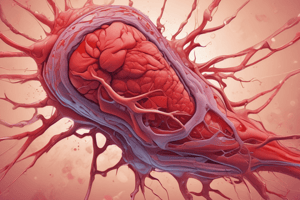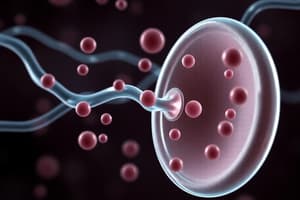Podcast
Questions and Answers
What is the primary function of hemostasis?
What is the primary function of hemostasis?
- To prevent blood from clotting too quickly
- To stop bleeding from a damaged blood vessel (correct)
- To maintain blood pressure within the circulatory system
- To facilitate blood flow through the circulatory system
Which of the following is NOT a component involved in maintaining hemostasis balance?
Which of the following is NOT a component involved in maintaining hemostasis balance?
- The fibrinolytic system
- Platelets
- The nervous system (correct)
- Coagulation factors
What is the primary purpose of a blood clot formed during hemostasis?
What is the primary purpose of a blood clot formed during hemostasis?
- Carry oxygen and nutrients to the damaged area
- Form a barrier to prevent excessive blood loss from a damaged blood vessel (correct)
- Prevent infection by sealing the wound from external pathogens
- Restrict blood flow to the damaged area, promoting faster healing
What is the Greek word for 'blood'?
What is the Greek word for 'blood'?
Which of the following is NOT a characteristic of the circulatory system?
Which of the following is NOT a characteristic of the circulatory system?
Which component is primarily responsible for the initial response to bleeding by forming a plug?
Which component is primarily responsible for the initial response to bleeding by forming a plug?
What is the main action during secondary hemostasis?
What is the main action during secondary hemostasis?
What is the primary purpose of a thrombus in the circulatory system?
What is the primary purpose of a thrombus in the circulatory system?
Which of the following involves the breakdown of a clot?
Which of the following involves the breakdown of a clot?
Which plasma proteins are involved in the inhibition of the hemostasis process?
Which plasma proteins are involved in the inhibition of the hemostasis process?
Flashcards
Haemostasis
Haemostasis
The process that prevents and stops bleeding.
Clot formation
Clot formation
The creation of a thrombus to occlude injured vessels.
Primary hemostasis
Primary hemostasis
Initial response involving platelet plug formation.
Secondary hemostasis
Secondary hemostasis
Signup and view all the flashcards
Fibrinolysis
Fibrinolysis
Signup and view all the flashcards
Coagulation Factors
Coagulation Factors
Signup and view all the flashcards
Study Notes
Haemostasis
- Haemostasis is the arrest of bleeding
- It is derived from two Greek words: haeme (meaning blood) and stasis (meaning to stop)
- Haemostasis balance is maintained in the body by complex interactions between coagulation, the fibrinolytic system, platelets, vessel walls, and coagulation factors.
Objectives
- Define haemostasis
- Differentiate between primary and secondary haemostasis
- Explain the functions of the vascular system
- Discuss the physiological role of platelets in haemostasis
- List and name coagulation factors
- Discuss the physiological role of coagulation factors in haemostasis
- Diagram and describe the intrinsic, extrinsic, and common pathway mechanisms of coagulation, including all factors involved in the reactions
- Define fibrinolysis
- Discuss the physiological role of the fibrinolytic system
- List the four main components of the fibrinolytic system
- Name the vitamin K-dependent factors
Introduction (cnt’d)
- Haemostasis is the property of the circulation which maintains blood as a fluid within the blood vessels and the system's ability to form a barrier (blood clot)
- The clot prevents excessive blood loss when a vessel is traumatized.
- The clot dissolves to ensure normal blood flow when the vessel is repaired
- Blood flows through a closed system of vessels called the circulatory system
- The blood vessels and their constituents control the physiological functions and integrity of the circulatory system
- A traumatic injury, such as a cut to the finger/toe, severing/cutting vessels, can result into bleeding
- To minimize blood loss, the normally inert circulating platelets and dissolved plasma proteins mobilize to form a clot, an insoluble mass or structural barrier (thrombus)
- The clot occludes the injured vessel and prevents further loss of blood; the clot's formation is limited to the injury area, so normal circulation is maintained in other vessels
- Briefly, control of bleeding requires rapid activation of platelets and plasma proteins to prevent blood loss. Hemostasis also includes fibrin (clot) dissolution and vessel repair
Introduction (cnt'd)
- These stages are the result of the interaction of platelets, blood vessels, and clotting/coagulation factors
- An upset in any of the stages can result in bleeding or abnormal blood clotting (thrombosis)
4 Primary Factors of Haemostasis Balance
- 4 Primary factors are blood vessels, platelets, plasma coagulation factors and fibrinolysis maintain the balance of hemostasis between clotting and bleeding
Primary Haemostasis
- During primary haemostasis, platelets interact with the injured blood vessels
- This interaction results in a mass of platelets known as the primary hemostatic plug/platelet plug, which temporarily arrests bleeding but is fragile and easily dislodged from the vessel wall
Secondary Haemostasis
- It involves the reinforcement of the unstable platelet plug with chemically stable fibrin
- Fibrin is formed by a series of complex biochemical reactions involving soluble plasma proteins (coagulation factors)
- They interact with the injured blood vessels and the platelet plug.
Secondary Haemostasis (cnt’d)
- The fibrin-reinforced plug, or thrombus, is called the secondary hemostatic plug
- The insoluble strands of fibrin become deposited on and within the primary platelet plug to reinforce and stabilize it and to allow the wound to heal without further blood loss
Fibrinolysis
- After the wound has healed, additional components of the hemostatic system break down and remove the clot to ensure the normal blood flow through the vessel
Fibrinolysis (cnt’d)
- Fibrinolysis functions to remove fibrin from the vascular system in a controlled manner once it has fulfilled its hemostatic function, to prevent excessive accumulation of fibrin
- Excessive fibrinolysis can result in bleeding
- An inadequate fibrinolytic response can cause delayed lysis of a thrombus and contribute to excess fibrin accumulation
Blood Clot Formation in Broken Vessel
- Illustrations depicting the steps involved in blood clot formation in a broken vessel
- Diagram illustrating the roles of clotting factors, platelets, and blood vessels in the formation of clots
Haemostasis
- Illustrations describing the different stages of haemostasis (injury, vasoconstriction, primary hemostasis, clot formation)
In Summary
- Haemostasis occurs because of the interaction of the blood vessels, platelets, and clotting factors
Studying That Suits You
Use AI to generate personalized quizzes and flashcards to suit your learning preferences.




